Advertisements
Advertisements
प्रश्न
"Migration may be interpreted as a spontaneous effort to achieve a better balance between population and resources." Examine the statement in context of pull and push factors that influence migration.
उत्तर
Migration may be interpreted as a spontaneous effort to achieve a better balance between population and resources. The two groups of factors that affect migration are as follows.
- The Push factors make the place of origin seem less attractive for reasons like unemployment, poor living conditions, political turmoil, unpleasant climate, natural disasters, epidemics and socio-economic backwardness.
- The Pull factors make the place of destination seem more attractive than the place of origin for reasons like better job opportunities and living conditions, peace and stability, security of life and property and pleasant climate.
APPEARS IN
संबंधित प्रश्न
What is ‘carrying capacity’ of a species in a habitat ? Why is logistic growth model considered more realistic?
If the birth rate is greater than the death rate then the population ______.
Examine the following statement and correct the incorrect one.
There is an adverse impact on manpower in the regions of out-migration.
Give Geographical Reason.
The real progress of a country is understood with the help of the Human Development Index.
Identify the correct correlation :
A: Assertion; R: Reasoning
A: In stage 2, the death rate reduces but the birth rate is constant.
R: The population increases rapidly in stage 2.
Write a short note on the correlation between birth rates and death rates.
Differentiate between
Crude Birth Rate and Crude Death Rate
Which country has the highest and lowest growth rate of the population respectively?
What is population growth? What does population change indicate for an area?
How did science and technology help in population growth?
Define the term ‘positive growth of population’.
Why do people migrate in large numbers from rural to urban areas in India?
What was the population of India as per the 2011 Census?
The growth of population rate per decade is ______.
The continent that has the highest growth rate of population.
Which one of the following is not a component of population change?
How many times the world population has increased during the last 500 years?
Which of the following is not a push factor for migration?
Which of the following attributes has not been adversely affected by Age and Skill selective migration?
Study the given graph carefully and answer the following question:
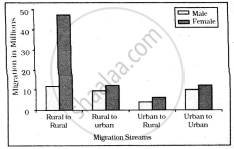
Intra-state Migration by place of Last Residence Indicating Migration Streams India, 2011
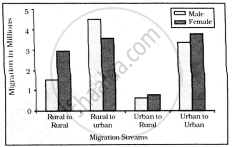
Inter-state Migration by Place of Last Residence Indicating Migration Streams India, 2011
Who dominates the inter-state migration of short distances?
On the basis of the demographic data of a country given below, construct an age pyramid and explain whether the population is stable, declining or growing.
| Age group | No. of individuals |
| Pre-reproductive | 20,000 |
| Reproductive | 15,000 |
| Post-reproductive | 10,000 |
Ratio between mortality and neutrality is called ______.
Exponential growth in plants win be expressed as ______.
Crude Death Rate (CDR):-
The term Crude Birth Rate (CBR) is closest to which of the following?
Which of the following pairs is not correctly matched?
Which of the following forms the component of a nation?
India's population is larger than the total population of which of the following?
In the exponential growth equation Nt = Noert, e represents ______
What would be the per cent growth or birth rate per individual per hour for the same population mentioned in the previous question (Question 10)?
In 2005, for each of the 14 million people present in a country, 0.028 were born and 0.008 died during the year. Using exponential equation, the number of people present in 2015 is predicted as ______.
What would be the growth rate pattern, when the resources are unlimited?
Comment on the growth curve given below.
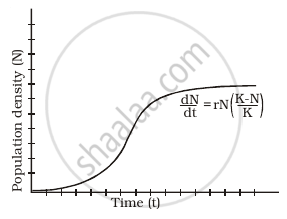
Which of the following may be interpreted as a spontaneous effort to achieve a better balance between population and resources?
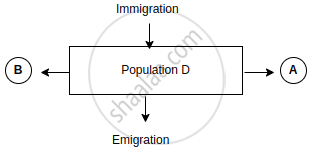
Observe the schematic representation given above and answer the following questions:
- Identify A and B.
- Calculate the growth rate of bacteria in a curd sample, where 1 million bacteria increased to two million, within a period of one hour.
Analyse the main features of Phase-III (1951 - 81) of growth of population in India.
Examine the different aspects of the growth of population in India during 1951-1981 and 1981-2021.
Assertion (A): The population of a region does not change.
Reasoning (R): Birth rate, death rate and migration affect the population of a region.
A: Population of a region does not change.
R: Birth rate, death rate and migration affect the population of a region.
Assertion (A): Population of a region does not change.
Reasoning (R): Birth rate, death rate and migration affect the population of a region.
Assertion (A): Population of a region does not change.
Reasoning (R): Birth rate, death rate and migration affect the population of a region.
Assertion: Population of a region does not change.
Reason: Birth rate, death rate and migration affect the population of a region.
Study the two figures shown below that represent two growth models.
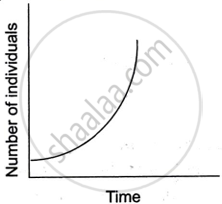 |
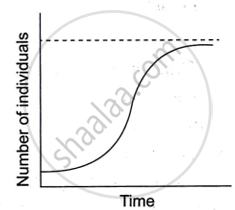 |
| Figure A | Figure B |
- Which one of the two figures represents an unlimited supply of nutrients? Give a reason.
- Which figure depicts a challenge to population growth?
- Explain the term reproductive fitness.
- Give the mathematical expressions for Figure A and Figure B.
Assertion : Population of a region does not change.
Reasoning : Birth rate, death rate and migration affect the population of a region.
